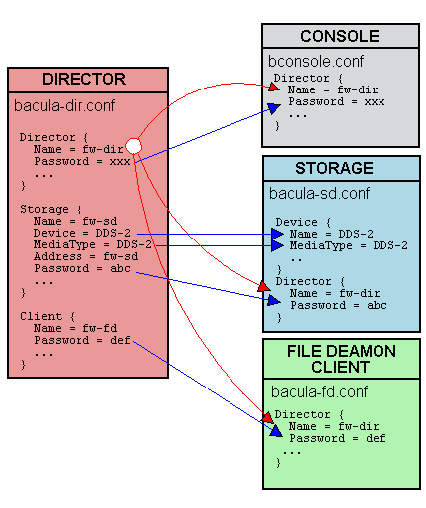Bacula Overview
Introduction:
Bacula is an on-linebased back up tool. Which is used to backup files from different servers into back up server where the bacula is running. For setup this backup tool across network first you have to install bacula server package on backup server machine where you are storing your backup contents ,and install bacula client daemon on all other servers from where we are going to backup data.
Bacula has five main components.
1.Director daemon
This daemon co-ordinate all working of backup,and through its configuration file we can specify all these things.
2.File daemon
This daemon works in all clients from that client we are backup data. Director daemon connect to this daemon after authentication and backup the files from this client.
3.Storage daemon
This daemon is for store the backup data from client in to hard disk of backup server,usually this daemon and director daemon works in the same backup server. director works as intermediate between the file daemon and storage daemon.
4.Console daemon
This is a terminal to control all works.This console connect to director daemon and using its commands we can define all things related with backup .
5.Catalog Database
The database used here is for store all information related to the backup, including the file indexing.Commonly used database for bacula is Mysql.
This figure shows how the different bacula daemon configuration files were linked together.

You can install bacula from rpm packages or from Source compilation. Here we are focusing on the source method,which is tested and is working fine.
For better manage Bacula we can structure the bacula configure file as below
# vi bacula-dir.conf
Director {
Name = bck01-dir
DIRport = 9101
QueryFile = "/opt/bacula/5.2.3/etc/query.sql"
WorkingDirectory = "/opt/bacula/5.2.3/var/bacula/working"
PidDirectory = "/var/run"
Maximum Concurrent Jobs = 1
Password = "mlaO4VoMtSztiaYYho4JBiLc2QIWbe2+os6c+5MmDyfT"
Messages = Daemon
}
Catalog {
Name = MyCatalog
dbname = "bacula"; dbuser = "bacula"; dbpassword = "bacula"; DB Address = "192.168.1.73"
}
Console {
Name = bck01-mon
Password = "Q1WBj91S2bJExh4xuXjfAB0tHQqkYZThrgsktrWqY+nQ"
CommandACL = status, .status
}
# JOBS
@/opt/bacula/latest/etc/common/jobs.conf
# FILESETS
@/opt/bacula/latest/etc/common/fileset.conf
# SCHEDULES
@/opt/bacula/latest/etc/common/schedule.conf
# MESSAGES
@/opt/bacula/latest/etc/common/message.conf
# CLIENTS AND STORAGE DAEMONS
@/opt/bacula/latest/etc/common/client.conf
@/opt/bacula/latest/etc/common/storage.conf
# VOLUME POOLS
@/opt/bacula/latest/etc/common/pool.conf
Director {
Name = bck01-dir
DIRport = 9101
QueryFile = "/opt/bacula/5.2.3/etc/query.sql"
WorkingDirectory = "/opt/bacula/5.2.3/var/bacula/working"
PidDirectory = "/var/run"
Maximum Concurrent Jobs = 1
Password = "mlaO4VoMtSztiaYYho4JBiLc2QIWbe2+os6c+5MmDyfT"
Messages = Daemon
}
Catalog {
Name = MyCatalog
dbname = "bacula"; dbuser = "bacula"; dbpassword = "bacula"; DB Address = "192.168.1.73"
}
Console {
Name = bck01-mon
Password = "Q1WBj91S2bJExh4xuXjfAB0tHQqkYZThrgsktrWqY+nQ"
CommandACL = status, .status
}
# JOBS
@/opt/bacula/latest/etc/common/jobs.conf
# FILESETS
@/opt/bacula/latest/etc/common/fileset.conf
# SCHEDULES
@/opt/bacula/latest/etc/common/schedule.conf
# MESSAGES
@/opt/bacula/latest/etc/common/message.conf
# CLIENTS AND STORAGE DAEMONS
@/opt/bacula/latest/etc/common/client.conf
@/opt/bacula/latest/etc/common/storage.conf
# VOLUME POOLS
@/opt/bacula/latest/etc/common/pool.conf
More detail:
http://karellen.blogspot.com/2012/01/basic-bacula-installation-and.html
http://www.sparksupport.com/blog/how-to-install-and-configure-bacula


Nhận xét
Đăng nhận xét